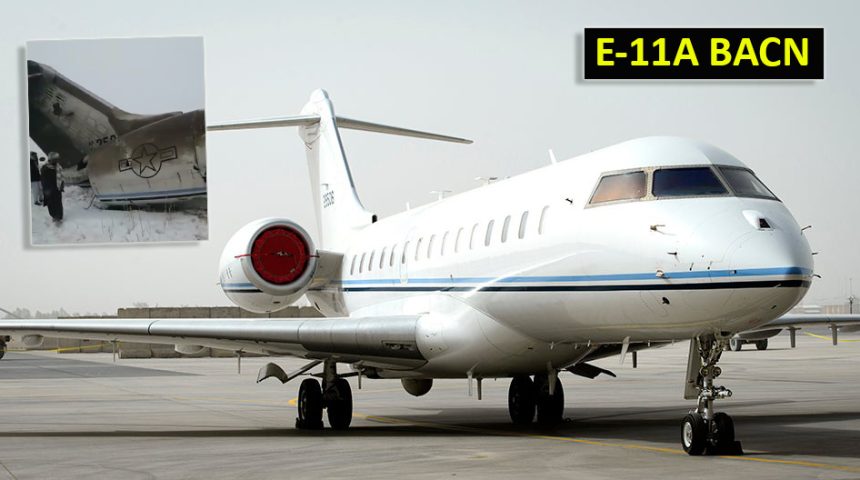Images coming from Ghazni clearly show the remains of a USAF E-11A BACN aircraft.
A U.S. Air Force’s E-11A BACN (Battlefield Airborne Communications Node) crashed during the morning on Jan. 27, 2020 in Afghanistan. The mishap happened in the Taliban-controlled area in Dih Yak, Ghazni. Early reports identified the jet as a passenger aircraft from Ariana Afghan Airlines, but the company immediately denied the reports.
In the meantime, however, photos and videos emerged on social media showed the remains of what clearly seems to be E-11A BACN, serial 11-9358. The tail section and the engines seem to be pretty intact in the video, with recognizable USAF roundels on the engine and the serial code on the vertical stabilizer. The rest of the fuselage and the cockpit burned up following the crash.
Wreck of plane crashed today in Afghanistan looks like to be a USAF Bombardier Global 6000 / E-11A “BACN” (Battlefield Airborne Communications Node)
Four U.S. E-11As are assigned to the 430th Expeditionary Electronic Combat Squadron and operate usually from Kandahar AB. pic.twitter.com/Uu4zrM8BAH
— Harry Boone (@towersight) January 27, 2020
VIDEO:
We have a clear footage now of the crashed plane. #Ghazni #Afghanistan pic.twitter.com/onlMjFiOma
— 🏴☠️ FJ 🏴☠️ (@Natsecjeff) January 27, 2020
That’s her!
11-9358 #USAF 🇺🇸
Hex AE4DE2
Bombardier E-11A pic.twitter.com/PafsUpxZBg
— Aleph 🕯️ א (@no_itsmyturn) January 27, 2020
The US Air Force has four E-11A (Bombardier Global 6000 advanced ultra long-range business jets that have been modified by the U.S. Air Force to accomodate Battlefield Airborne Communications Node payload) assigned to the 430th Expeditionary Electronic Combat Squadron operating out of Kandahar Airfield.
These aircraft can be regularly tracked by means of ADS-B/Mode-S as they operate over Afghanistan.
Here’s what our editor David Cenciotti wrote in a previous article about the BACN payload:
The U.S. military uses various datalink systems to exchange tactical information, and many are not capable of working together. For example, a U.S. Air Force F-15 can use its Link-16 system to exchange target information with a U.S. Navy F/A-18. However, the F/A-18 could not exchange information with a USAF B-52 or B-1 bomber. The advanced F-22 can connect with other Raptors via datalink but can only receive over the standard, legacy Link-16 datalink used by most allied aircraft.
This lack of compatibility between different platforms is a major obstacle in all those theaters where air assets from many services are called upon to provide support for ground troops of different nations. Additionally, the complicated joint operations required to engage a modern integrated air defense system are greatly simplified by exchanging target information via datalinks.
Hence the need for a “flying gateway” as the EQ-4.
The BACN system is also used to link ground troops and Forward Air Controllers (FACs)/Joint Terminal Attack Controllers in a non-line-of-sight (LOS) environment. For instance, in the rugged, mountainous terrain of Afghanistan, troops are not always able to establish LOS communications with close support aircraft overhead. Moving position or relocating to higher ground could be fatal in a combat situation.
Someone pointed out the fact that the aircraft #11-9358 did not sport the bulges featured by the article #11-9001. However, the “canoe” and “teardrop” on tail number #9001 have nothing to do with the BACN payload as explained in an article published by Tyler Rogoway at The War Zone in 2017:
The E-11A that has a “canoe” on the bottom and a “teardrop” on the top is aircraft tail #9001, which is affectionately referred to as “Snowball.” 9001 was the first E-11A fielded with the BACN payload, and it was also the BD-700 test aircraft. The “canoe” and “teardrop” do not contain any additional equipment or provide any additional capability, they are left over from previous flight test efforts.
At the time of writing, there is no confirmation yet from official US sources about the crash itself, the causes or the casualties. Also, Taliban forces did not claim any responsibility.
We will update the story as new details emerge.









